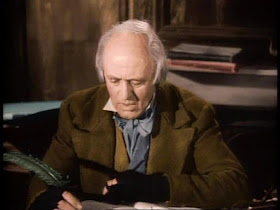 |
| Daniel Massey, Julie Andrews, Richard Crenna |
STAR! (1968). Director: Robert Wise.
It must have seemed like a good idea back in the sixties. Let's take the director of the mega hit
The Sound of Music, Robert Wise, and team him up with Julie Andrews, the star of not only that film but of
Mary Poppins. This was the period of big, long
"road show" movie musicals, and everyone must have figured
Star! would be one of the biggest and most successful of them all. Boy, were they wrong! Let's get one thing straight at the start.
Star! didn't fail because tastes had changed (even if they had); it failed because it was
bad.
 |
| "Poor Jenny" from Lady in the Dark |
Even if
The Sound of Music hadn't been based on a hit musical, it had a compelling story line.
Star! is not based on anything but the life of Gertrude Lawrence, best known to those of us today as the star, with Yul Brynner, of the wonderful Rodgers and Hammerstein Broadway musical
The King and I. She had only a few film appearances, and while she was well-known in theatrical circles, she was perhaps not quite a household name. So
Star! was already lacking built-in pre-appeal. Then there was the fact that the only thing Lawrence and Andrews had in common is that they were British; Andrews simply wasn't able to successfully approximate the real Gertrude Lawrence. The sketches and songs early in the picture that are meant to be funny fall completely flat because Andrews, despite her talent, is no Lucille Ball -- nor Lawrence. Andrews makes a good try at coming off like a tempestuous and difficult diva (which is how the film tries to portray Lawrence ) but she just can't get that far away from Maria Von Trapp.
 |
| Spending spree at Cartier's |
Star! provides some basic facts of Lawrence's life, although it fictionalizes and exaggerates a lot and combines two suitors, a banker and a small-time producer, into one character (Richard Crenna). Her other suitors include a military captain (Michael Craig), another actor named Charles (Robert Reed), a show biz type briefly essayed by Anthony Eisley, and a husband named Jack (John Collin), who is nothing much like Lawrence's actual first husband. Her closest relationship is probably with Noel Coward, played herein by a de-sexualized Daniel Massey. (The production saved money no doubt by casting male actors who couldn't command large fees.) The film also details her troubles with debts and taxes that nearly landed her in jail, and one of the best scenes has her dramatically declaiming before a a judge (Murray Matheson of
Wall of Noise) in bankruptcy court. Lawrence spent much more than she earned, thinking nothing of, say, dropping into Cartier's to buy whatever she fancied.
 |
| "He Never Said He Loved Me" |
There are several production numbers in the film, staged by actor-choreographer Michael Kidd [
It's Always Fair Weather], but most of them are unmemorable, campy, too-weird, or all three. The "Poor Jenny" number from
Lady in the Dark is at least lively, but also staged in a way that is more stupid than inventive. There is a silly number set in a Limehouse brothel that could have used more dancing. The one production number I enjoyed, very well performed by Andrews, was one in which she appears to be a harem girl singing about how her doctor loves all of her separate parts but "He Never Said he Loved Me." It has the whimsy that the rest of the film is lacking. At another point Andrews sings a simple love song on a bare stage and nails it beautifully.
The movie makes the mistake of proceeding as a documentary of Lawrence's life which the lady herself is watching and commenting on. Although this is a widescreen picture, about half the movie uses about only a third of the screen to reproduce black and white newsreels. It's a dumb and pointless approach. But then the whole project was ultimately pointless, laying an egg at the box office, almost killing off Andrews' career, incurring the wrath of bored critics, and doing little to revive interest in the real Gertrude Lawrence, considered one of the greatest theatrical talents of the 20th century -- more's the pity. The movie never even mentions her appearance in the film version of
The Glass Menagerie, nor --shockingly -- her triumph in
The King and I.
Verdict: Ten good minutes out of three hours (!) is not enough to save this movie. **.









































